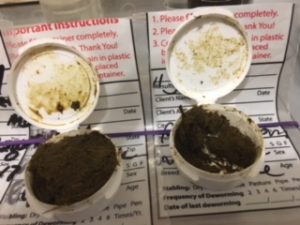By John Byrd, DVM
When I started Horsemen’s Laboratory, over 25 years ago, I asked the same question and searched for a container that would preserve the sample and the eggs and be suitable for shipping. Along the way, I spoke to several experts in the field of equine parasitology and they agreed that our container and packaging should work.
Horsemen’s Laboratory’s First Years
In our first year we tested 207 samples, 77% of the samples were negative and 23% were positive. The second year we tested 407 samples and the results were about the same with 80% negative 20% positive.
Problems Early On
Early on, I noticed a problem with the Strongyle eggs hatching and sometimes there were larvae floating and swimming in some of the positive samples, in these cases we counted each larva as an egg. I also noted that when we received multiple samples sent in one envelope some of the samples would have larvae in them, while in the other samples the eggs appeared as though they had just been passed by the horse.
The Answer to Hatching and Embryonated Eggs is Oxygen
I continued to see this occurring and wondered why some eggs evidently took longer to hatch than others. I assumed it was due to the species of the Strongyle. However, several years ago I attended a conference at the University of Kentucky where I met Dr. Martin K. Nielsen, an expert on equine parasitology, and I had the opportunity to ask him this very question. His answer was simply that the eggs needed oxygen to develop and hatch. Strongyle eggs in the absence of oxygen do not embryonate or hatch, therefore, when there is not enough oxygen in the container the eggs will not hatch.
To Eliminate Oxygen Firmly Pack and Fill Container
This is why we now instruct our clients to firmly pack the container we provide full of stool, eliminating any space for oxygen. This has considerably cut down on eggs hatching and we only find larvae swimming or floating in the samples that are not firmly packed. The eggs in the well packed samples have not started to embryonate (no larva have formed inside the eggs) when Horsemen’s Laboratory receive them.

Properly Packed (left) & Improperly Packed (right)



